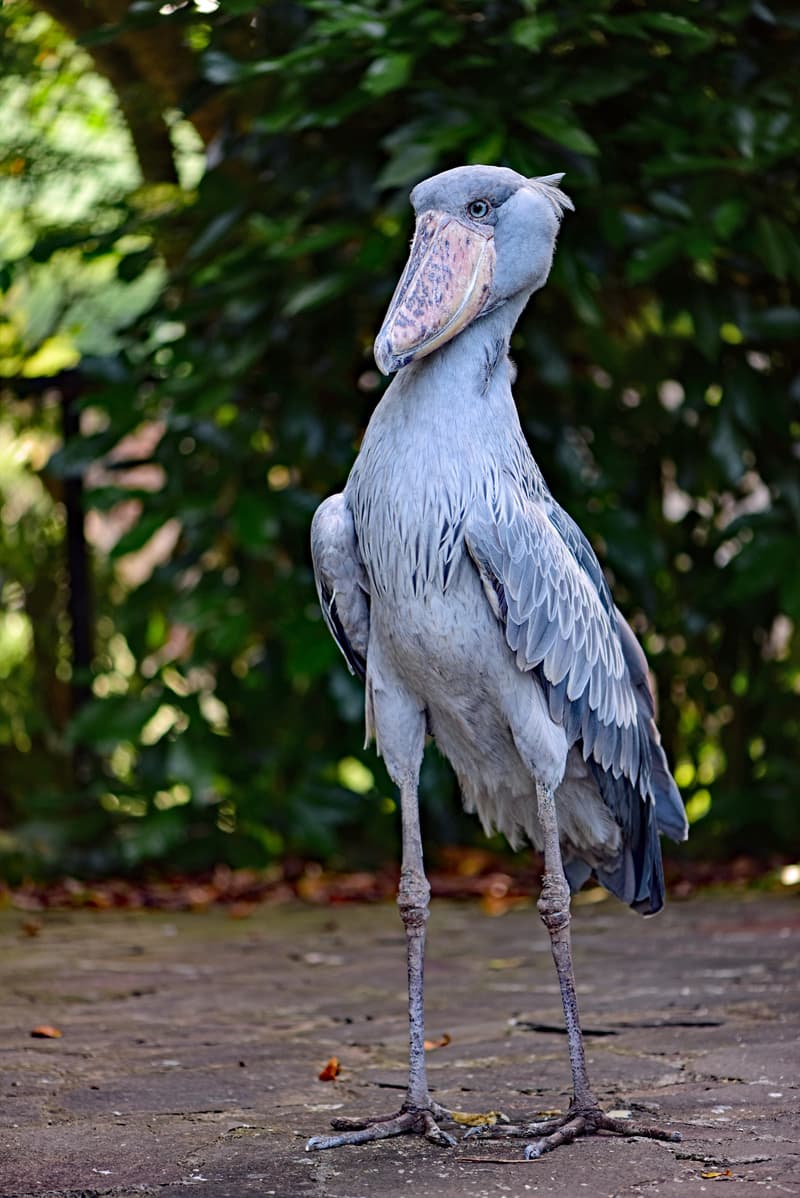

The breeding season is the height of this stork’s attractiveness. Juveniles have wooly down on their head, black plumage and a smaller bill. The legs and feet appear to be white because of excrement. This contrasts with the thick, downy, off-white feathering of the underparts. The wings are glossed with green while the back and mantle are glossed with blue. The wings, back and tail are a slaty grey.

A ladder of white bands forms on the edges of the cloak, the greater secondary coverts. This bird is also referred to as the “undertaker bird”, the name originates from its cloaked appearance when viewed from behind as well as its hunched head, tufts of white hair on the nape, and long, skinny legs. The outsized bill ranges from horn-colored to greenish yellow. The neck and gular sac are pink or magenta. A few sparse hairlike feathers are scattered over the crown and neck. It is usually hidden by the white ruff that encircles much of the lower neck. At the base of the nape there is another air sac, crimson in colour, with a diameter of 10 to 15 cm that can inflate to seven cm high. They also dot the gular sac that hangs down anywhere from 25 to 35 cm when inflated. The marabou stork’s orange-red head has black spots that are concentrated towards the forehead and base of the bill. We appreciate your patience during this exciting fundraising event! Old Finch Ave from Reesor Rd to Meadowvale Rd.

Plug Hat Rd from Beare Rd to Meadowvale Rd.Meadowvale Rd from Sheppard Ave to Plug Hat Rd – Local access maintained to Toronto Zoo, but guests may experience traffic delays.Parking - Guests may be redirected to the Zoo’s overflow parking lots 2 and 3 located on the east side of Meadowvale Rd across from the Zoo.Wildlife Health Centre Viewing Gallery: Opens at 12:00 pm.Tundra Trek & Mayan Temple: Access to the Caribou habitat and Mayan Temple will be closed for the duration of the run and may remain closed for the entire day.

Guests may experience slight delays on other pathways as the ZooRun finishes and the race route is cleared.
#Shoebill stork zoo series
Please be advised that your Toronto Zoo and Canada Running Series will be hosting the Oasis ZooRun at the Zoo on September 16 to raise funds for your Toronto Zoo Wildlife Conservancy. Late Zoo Opening & Other Operational Impacts However, our plants have been moved outside and are still viewable by the Wildlife Health Centre. Please note that the Greenhouse is closed for renovations. Snow Leopards will be temporarily unavailable for viewing starting September 11. Steller's sea eagles are temporarily relocated and now on display in the Canadian Domain. Please note, the following animals may not be viewable at this time: Since the rookery's inception, JZG staff has provided veterinary care for any injured birds. Over the last eleven years the JZG rookery has been one of the most productive in the Southeastern U.S, and volunteers have logged hundreds of hours monitoring its success.Please note that the new Outdoor Orangutan Habitat will be closed until 1:00pm on weekdays, as well Zoomobiles will no longer offer commentary approaching the new habitat while our orangutans are getting used to their new home. The program plans to use banded storks to monitor nest attendance by sex and to determine the site fidelity of the species. Fish and Wildlife Service (USFWS) and resulted in Jacksonville Zoo and Gardens' (JZG) Wood Stork Conservation Project and Partnership with the USFWS in 2003 when careful monitoring began.īanding of nestlings began in 2003, the following year JZG began satellite tagging and banding adult wood storks. This was brought to the attention of the U.S. In 1999, a new wood stork rookery formed on Zoo grounds and it soon began to show signs of annual growth. population of wood storks is listed as threatened under the Endangered Species Act (ESA) and is fully protected by Florida state and federal laws. The principle reason for the ESA listing is related to its decline from an estimated 20,000 nesting pairs in the 1930s to a low of about 3,000-5,000 pairs in the 1970s. Wood Storks Location: Jacksonville, Florida


 0 kommentar(er)
0 kommentar(er)
